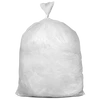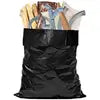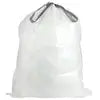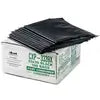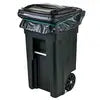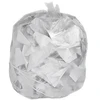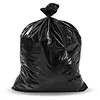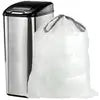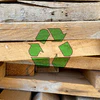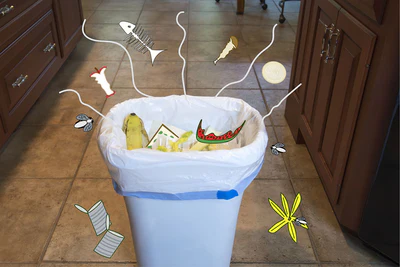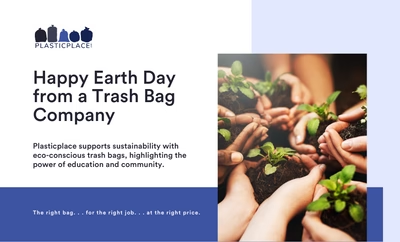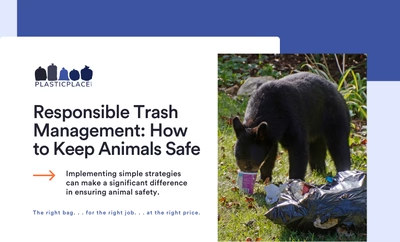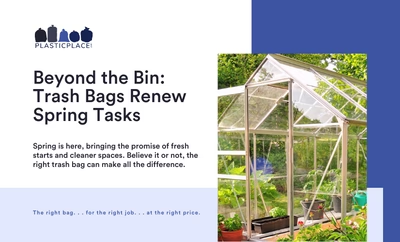From the time you wake up to the time you go to sleep at night, you’re generating trash. When you toss a banana peel from breakfast, plastic wrap from the Amazon order that showed up on your porch or the packaging from the chicken cutlets you cooked for dinner, all of that waste has to go somewhere after it hits the trash bag. So, where does trash go, exactly?
Understanding what happens to our waste after we throw it away is an important part of learning how to live and work more sustainably. With the average American generating 4.9 pounds of trash every day, waste management has a big effect on our environment and our communities. Each of us owes it to the planet and to each other to do our part to reduce our waste footprint.
It’s time for some straight talk about where our trash goes. In this guide, we’ll talk about how people are starting to clean up the act when it comes to waste disposal practices, and the best eco-friendly trash bag options available for your waste disposal needs.
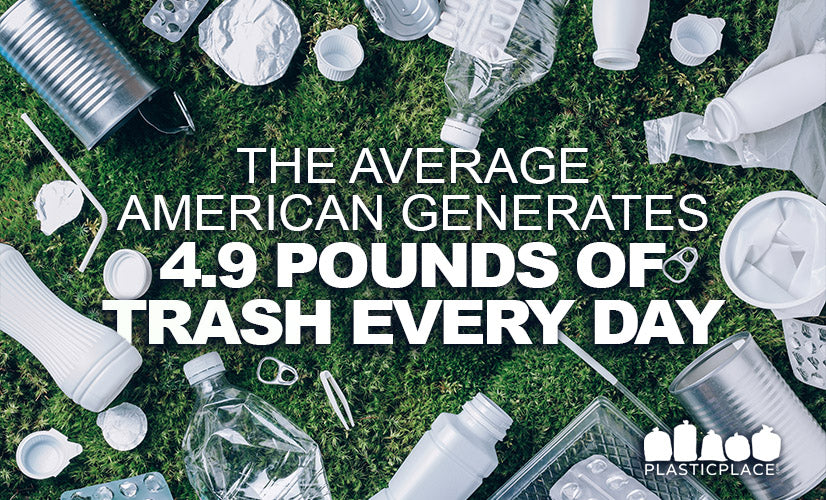
The Trash Can and the Recycling Bin
First, let’s get our story (terms) straight. Most homes and businesses separate waste into two categories: trash and recycling. The most common definitions of these categories are:
- Trash includes anything from food and yard waste to bulky items like appliances. What these items have in common is there’s usually no efficient way available to reclaim them for their materials, so they instead go to landfills or incinerators.
- Recycling includes specific materials like glass, cardboard, aluminum and HDPE plastic a manufacturer can process into new manufacturing materials. Other manufacturers then use these materials as a feedstock for post-consumer recycled goods, such as eco-friendly trash bags.
Composting, which we’ll discuss later on, is a third option that isn’t yet as widespread as the ubiquitous trash and recycling bins, although it’s gained a foothold in some places. Some facilities, such as hospitals or chemical factories, might also have additional waste streams if they need to dispose of hazardous waste.
Where Does Trash Go? Explaining the Waste Disposal Process
Once you’ve placed the contents of your garbage and recycle bins on the curb, the waste begins its journey through our municipal solid waste (MSW) disposal systems. We start our analysis with waste collection and then move on to the many different final destinations to which sanitation systems send waste.
Waste Collection
Garbage and recycling collectors are the front line of the waste industry. They collect the contents of your trash and recycling bins in a garbage truck and transport it to different types of waste processing facilities. (In some rural areas, you might have to take your trash and recycling to a dump.)
Ultimately, after sorting through your 55-gallon trash bags, your trash or recycling will almost always end up in one of four places. What are these disposal methods, and how do they compare in terms of how much waste they handle?
- Landfills (146.1 million tons)
- Waste incinerators (34.6 million tons)
- Recycling centers (69 million tons)
- Composters (25 million tons)
Let’s take a quick look at these four potential destinations and what happens in each one:

Landfills
Landfills might not give you a scenic vista, but they’re important parts of how we collect and manage waste. There are over 1,250 landfills in the United States, and they collect vast amounts of waste that can’t be recycled or composted. Mostly, that means the MSW waste stream that we discussed earlier, but landfills also often include construction and demolition (C&D) waste like wood, brick, concrete and more.
Still, a landfill is much more than just a pit full of garbage. In fact, modern landfills are highly engineered pieces of infrastructure, with layers of clay, plastic and wastewater-carrying pipes interspersed throughout. These features help protect surrounding communities and natural areas from contaminated wastewater that may be present in the landfill.
Ultimately, it’s important we keep as much waste out of landfills as possible. A lot of the trash that goes into landfills will either never break down or take decades or centuries to do so. Many people now choose to purchase durable goods and use alternate waste disposal strategies to minimize the amount of waste that gets landfilled.
Waste Incinerators
Depending on where you live, your MSW stream might go to an incinerator rather than a landfill. Many communities have trash incinerator facilities that can burn large quantities of waste.
One of the most exciting things about waste incinerators is they can produce electricity to power homes, businesses and infrastructure. The surplus heat from the combusting trash is useful as a source of electrical power, although most places in the U.S. don’t have the infrastructure to make waste incinerators a substantial part of the electrical grid.
The downside of waste incinerators is they release environmental pollutants. In the U.K., where waste burning is a relatively common practice, activists claim the process emits a ton of CO2 into the atmosphere for every ton of trash burned. In the end, the drawbacks of this method may outweigh the benefits, but opinions differ widely.
What about burning your own trash from your home or business? In most cases, it’s not a good idea. It’s easy for the fire to get out of control, the burning waste can often release toxic pollutants and there’s a good chance it’s illegal in your state and/or city. The only major exception is yard waste which many municipalities allow people to burn under certain, strict conditions.
Order Eco-Friendly Trash Bags to Start Reducing Your Carbon Footprint
Recycling Centers
Recycling centers are where municipal recycling streams come to be sorted and processed. Typically, a recycling center’s main job is to sort items from the recycling stream and package them together. Other businesses then purchase the bundled recyclable waste to turn it into post-consumer glass, plastic, cardboard and other materials.
Your recycling center uses a variety of technologies to separate recyclable materials from non-recyclable ones that belong in the trash or compost waste streams. One of the most common methods, single-stream recycling, includes everything from magnets to a mechanical claw. Recycling centers also clean recyclables, such as glass, to increase their resale value.
However, it’s still important to minimize your environmental impact by preparing your recycling as well as you can. That means keeping non-recyclable items out, including greasy pizza boxes, food scraps and anything else a recycling center can’t process. Cleaning off dirty glass, such as a pasta sauce jar, before you dispose of it will also help make the recycling center’s job easier.

Composting
Finally, some kinds of food and yard waste can also be composted. This waste disposal method puts the biological processes of decomposition, involving lots of tiny bacteria and invertebrates, to work in breaking down food and lawn scraps. The result is a rich blend of nutritious materials that’s perfect for enriching soil in all kinds of gardening projects. That’s a win for the environment and for your garden.
It’s possible to start your own compost for personal use almost anywhere, including your home or backyard, although you should check local laws to learn whether you might need a composting permit. Increasingly, however, local governments and businesses also offer composting services. While these aren’t yet truly widespread, they’re gaining popularity as many people look for sustainable waste disposal solutions.
There are several different methods of composting, including:
- Anaerobic Composting: Composting without introducing oxygen or moisture. This type of composting is extremely low-effort, but it produces strong and often unpleasant odors. It can also release large amounts of methane which is a potent greenhouse gas. Some anaerobic composting occurs naturally in landfills.
- Aerobic Composting: Composting that introduces oxygen and water by turning, aerating and moistening the mixture. Aerobic composting takes more effort than other types, and it can still produce smells. That said, it’s generally the most efficient and accessible type of composting for both individuals and communities.
- Vermicomposting: Composting that uses earthworms to break down biological products in compost. Vermicomposting is highly efficient and gaining popularity, but it isn’t a big part of most municipal composting solutions just yet.
Composting infrastructure varies a lot by where you live and work. Some areas have robust municipal composting programs, while others may rely on nonprofits, businesses or private citizens for any organized composting. Many people simply compost in their home or yard.
Want to know how to make compost in a garbage bag? We show you a super-easy way to do it with minimal supplies.

Reducing Your Waste Footprint
Most of us have heard the phrase “reduce, reuse and recycle” at some point. When you’re considering how to reduce your waste footprint, it’s important to understand how these concepts apply. They’re ordered from most preferable to least preferable:
- Reduce: Whenever it’s feasible, your first choice should be to reduce the amount of waste you generate. For example, you might get a durable glass or stainless steel water bottle rather than drinking water in single-use plastic bottles.
- Reuse: When you do generate waste, investigate ways to reuse it at least once. You might use J, or utilize empty coffee cans to store nails and screws or plant a basil plant in last night's tomato sauce can!
- Recycle: If you have to use disposable products, try to choose ones that are recyclable or made from recycled materials. Choosing eco-friendly recycled trash bags, for example, can reduce the amount of virgin plastic that’s used to create new bags.
There are an untold number of different ways you can put the three Rs into action. Many you may have already heard of. However there are some methods of reducing waste that do not always get the attention it deserves. One place to start….choosing a more sustainable type of trash can liner to deal with your home or business waste.
Choosing More Eco-Friendly Trash Bag Options
Businesses and consumers are more conscious than ever of how their decisions impact the planet. Demand for sustainable products is high, and one of the most important areas in which we can create sustainability is in how we dispose of our waste. Trash bag brands, like Plasticplace offes entire collections dedicated to being eco-friendly Many businesses and consumers choose to buy post-consumer recycled trash bags to help reduce their waste footprint. In many cases, this is an easy win: Recycled trash bags are just as tough and durable as non-recycled ones, and they’re available at a similar price point. Browse Plasticplace’s selection of recycling bags to see the outstanding choices we offer.
Trash compactors are also a popular choice for reducing one’s landfill footprint. These machines pack trash into a smaller and more manageable form that occupies less space. Do note that to use most of the smaller compactor models, you’ll need to purchase special trash compactor bags that you can cut to fit the size of the compactor.

Biodegradable garbage bags decompose naturally after disposal in a landfill. This allows for lessening your carbon footprint, less greenhouse gas emissions and is ultimately better for the planet.
Instead, if you want a greener garbage bag, consider using compostable trash bags to dispose of yard waste, food scraps and other compostable materials. These bags are made from a special plastic that is actually compostable in an industrial composting facility. (Note that they shouldn’t be used for backyard composting.)
Learn About Biodegradable Garbage Bags Here!
Plasticplace is proud to be a partner in sustainability to all of our home and business customers. See our entire eco-friendly garbage bag collection, or check out our explainer on how to choose the right garbage bag if you need some basic info on making the right can liner choice for you. Don’t forget — our friendly customer service is available to answer your questions at 732-838-5630.
Image Credits:
j.chizhe/Shutterstock.com
shopplaywood/Shutterstock.com
Dalibor Danilovic/Shutterstock.com
Electric Egg/Shutterstock.com
 4.9 out of 5
4.9 out of 5 












